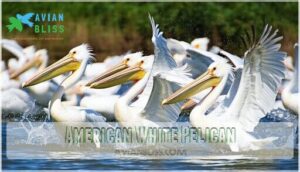This site is supported by our readers. We may earn a commission, at no cost to you, if you purchase through links.
 Amazing bird facts about their beaks reveal nature’s incredible engineering. You’ll find that a bird’s beak acts as its Swiss Army knife—serving as nose, mouth, and multi-tool all in one.
Amazing bird facts about their beaks reveal nature’s incredible engineering. You’ll find that a bird’s beak acts as its Swiss Army knife—serving as nose, mouth, and multi-tool all in one.
These fascinating structures never stop growing, requiring constant use to stay sharp. Unlike mammals, birds pack no teeth, relying entirely on their beaks for survival.
Each shape tells a story: hooked beaks tear flesh, cracker-style beaks crush seeds, and tweezer beaks snatch insects with precision. From pelicans with the world’s longest beaks to sword-billed hummingbirds whose beaks outstretch their bodies, these adaptations showcase millions of years of evolution.
The secrets behind specialized beaks go deeper than you’d expect.
Table Of Contents
- Key Takeaways
- What is a Bird’s Beak?
- Beak Shapes and Diets
- Unique Beaks in Birds
- What Do Birds Use Their Beaks For?
- Beak Functions and Characteristics
- Types of Beaks
- Amazing Beak Facts
- Frequently Asked Questions (FAQs)
- Do birds have different beaks?
- Why are bird beak types important?
- Why does a bird have a long beak?
- What is a bird beak?
- What birds have a long beak?
- How strong is a bird’s beak?
- What is interesting about the bird beak?
- What bird has the most unique beak?
- What bird has the largest beak?
- Do birds have big beaks?
- Conclusion
Key Takeaways
- You’ll find that bird beaks are actually living multi-tools made of keratin that continuously grow throughout their lives, requiring constant use to stay sharp and properly sized.
- Each beak shape directly determines what a bird can eat – hooked beaks tear meat, cone-shaped beaks crack seeds, tubular beaks probe flowers, and specialized shapes like crossbills’ twisted tips unlock specific food sources.
- Bird beaks serve far more purposes than just feeding, functioning as temperature regulators, communication devices, nest-building tools, grooming instruments, and even weapons for defense.
- Some of nature’s most extreme beak adaptations include pelicans with 47-centimeter beaks, sword-billed hummingbirds whose beaks exceed their body length, and black skimmers with asymmetrical beaks that slice through water while flying.
What is a Bird’s Beak?
You’ll discover that a bird’s beak is actually a remarkable multi-tool made of bone and keratin that serves as both nose and mouth.
Unlike mammals, birds have no teeth, so their beaks must handle all the work of catching, holding, and processing food.
The Beak is a Bird’s Nose and Mouth
Think of your bird’s beak as nature’s ultimate multi-tool – it’s both nose and mouth rolled into one incredible design.
Nature’s Swiss Army knife – every bird’s beak is a perfectly engineered multi-tool for survival.
When you watch birds, you’re seeing beak breathing and olfactory senses working together seamlessly. Those tiny nostrils aren’t just for show; they’re processing scents while the beak handles feeding duties.
Birds rely on sensory integration to navigate their world. Their beaks house receptors for taste perception, helping them identify safe foods from harmful ones.
The vocalization role of beaks shouldn’t be overlooked either – many species use beak positioning to modify their calls.
Bird beak morphology reveals evolution’s genius. Each species developed beak adaptations matching their lifestyle.
Hooked beaks slice through meat like nature’s scissors, while filter-feeders sport specialized strainers. This beak function diversity showcases how bird feeding strategies shaped these remarkable tools over millions of years.
There Are No Teeth in a Bird’s Beak
Unlike humans, you won’t find a single tooth in any bird’s beak throughout their evolutionary history.
Instead, birds rely on their gizzard function and specialized swallowing mechanisms to process food.
This toothless design offers remarkable advantages:
- Lightweight skulls enhance flight efficiency
- Streamlined beak strength maximizes feeding precision
- Alternative digestion processes food internally
- Versatile beak adaptations suit diverse bird anatomy needs.
Interestingly, birds evolved from ancestors that had teeth like structures.
Beaks Continuously Grow
Your bird’s beak isn’t static—it’s a keratin masterpiece that never stops growing.
Just like your fingernails, beak growth continues throughout a bird’s life.
This constant regeneration process helps counter natural wear patterns from daily use.
Growth factors determine how fast different species need beak maintenance.
Without this ongoing beak repair, birds couldn’t survive their demanding lifestyles requiring constant beak sharpening against surfaces.
Main Functions of The Beak
You’ll discover that beaks serve as multipurpose tools beyond simple feeding.
These remarkable structures handle everything from Communication and Nest Building to Feather Preening and Temperature Regulation. Beak adaptations enable diverse feeding strategies that perfectly match each bird diet.
Here are four essential beak functions:
- Feeding Techniques – Capturing, processing, and delivering food efficiently
- Nest Building – Weaving, shaping, and constructing safe homes
- Feather Preening – Maintaining plumage health and waterproofing
- Communication – Drumming, tapping, and producing social signals
Beak Shapes and Diets
You’ll discover that nature has crafted bird beaks like specialized tools, each perfectly matched to what they eat.
When you look at different birds, their beak shapes tell the story of millions of years of evolution creating the perfect dining utensil for their favorite foods.
The Shape of a Beak Dictates a Bird’s Diet
You know how some tools work better for specific jobs? Bird beaks follow the same principle through evolutionary pressures that shaped feeding strategies over millions of years.
Beak morphology directly determines dietary specialization, creating perfect niche partitioning among species:
- Hooked beaks: Raptors tear meat with razor-sharp precision
- Conical beaks: Finches crack seeds like tiny nutcrackers
- Tubular beaks: Hummingbirds probe deep flowers for nectar
These beak adaptations showcase nature’s engineering at work!
Different Types of Beaks and Their Functions
Nature’s toolbox contains remarkable beak types, each perfectly crafted for specific jobs.
You’ll find drilling beaks that chisel wood, tweezer beaks that pluck insects, and filter-feeding beaks that strain water like tiny sieves.
These beak adaptations showcase incredible functional diversity and evolutionary adaptations.
| Beak Type | Primary Function | Amazing Ability |
|---|---|---|
| Drilling | Excavate wood | Creates perfect nest holes |
| Filter-feeding | Strain water | Catches thousands of tiny prey |
| Probing | Search soft ground | Feels prey underground |
Each bird’s beak morphology matches its dietary niche perfectly.
Feeding strategies vary dramatically – some birds use their beaks like hammers, others like straws.
This bird feeding specialization means every species has found its perfect beak function through millions of years of fine-tuning.
Hooked Beaks
You’ll spot hooked beaks on nature’s top predators.
Nature’s most lethal predators sport razor-sharp hooks that slice through prey with surgical precision.
These powerful tools evolved for raptor hunting, letting birds tear flesh with incredible beak strength. The sharp curve and specialized diets make them perfect killing machines.
Raptors are defined by their distinct hooked beak, sharp talons, and keen eyesight.
- Tearing Mechanisms: Sharp hooks rip through tough meat and hide
- Hooked Evolution: Curved tips developed for maximum grip on prey
- Beak Adaptations: Strong keratin structure withstands fierce struggles
Cracker-style Beaks
Cracker-style beaks pack serious crushing force.
These cone-shaped powerhouses let finches and cardinals crack tough seeds like nature’s nutcrackers.
Beak morphology perfectly matches diet specialization—thick, short bills generate maximum pressure for seed cracking.
Finch evolution shaped these tools over millions of years, creating the perfect seed-busting machine for granivorous birds.
Tweezer Beaks
Picture a bird’s tweezer beaks as nature’s finest surgical tools.
These slender, pointed instruments let warblers and wrens master insect foraging with pinpoint accuracy.
Specialized beaks evolved for crevice feeding, plucking beetles and caterpillars from bark cracks where broader beaks can’t reach.
Warbler diets depend on this precision engineering for survival success.
Some birds, like shrikes, even have sharp hooked beaks for tearing apart their insect prey.
Probing Beaks
While tweezer beaks pick insects with precision, probing beaks work differently.
These elongated tools excel at reaching deep into flowers and crevices where other birds can’t access food. Their bill morphology creates perfect instruments for specialized foraging depths and enhanced sensory perception.
- Evolutionary pressures shaped these beaks for nectar feeding and deep prey detection
- Curved designs help birds navigate flower tubes and tree bark cracks
- Sensitive tips detect hidden insects through touch and vibration
- Length varies based on bird feeding habits and preferred food sources
Unique Beaks in Birds
You’ll discover some of the most remarkable beaks in the bird kingdom that look like they came straight from a fantasy novel.
From hummingbirds with beaks longer than their entire bodies to pelicans with beaks longer than baseball bats, these incredible adaptations will amaze you.
Pelicans Have The Longest Beaks in The World
When you spot a pelican’s beak, you’re looking at nature’s longest—up to 47 centimeters in Australian pelican species.
This incredible beak structure combines lightweight bones with a massive gular pouch for pelican feeding.
The beak size helps with beak temperature regulation too, releasing excess heat like a built-in air conditioner.
Bird beaks don’t get more impressive than this fishing net on wings!
North American Birds With Unique Beaks
North America hosts some remarkable bird species with extraordinary beak adaptations.
You’ll find the American White Pelican boasting impressive Pelican Size with bills reaching over 15 inches, perfect for cooperative fishing.
The Skimmer Adaptation of Black Skimmers features a longer lower mandible that slices through water while flying.
Roseate Spoonbills display stunning Spoonbill Coloration from their crustacean diet, using spatula-shaped bills for filtering.
Long-billed Curlews showcase extreme Curlew Diet versatility with 8-inch curved bills for probing deep mud.
These bird beaks demonstrate how beak shapes perfectly match feeding strategies, making bird identification easier across diverse North American bird species.
Crossbills
Why do crossbills have twisted beaks? They’re nature’s pinecone experts.
These specialized bird beaks evolved perfectly for cone specialization and seed extraction.
Here’s how crossbill mandibles work their magic:
- Twisted tips grip pinecone scales like pliers
- Powerful jaw muscles pry open stubborn cones
- Curved design reaches seeds other birds can’t access
- Juvenile beaks develop crossover pattern as they mature
- Evolutionary advantage lets them dominate conifer forests
This beak specialization showcases incredible bird beak evolution and adaptation.
American White Pelican
American White Pelicans boast massive gular pouches that work like fishing nets.
You’ll spot these masters of cooperative fishing working together in breeding colonies, using their specialized bird beaks to scoop up fish.
Their incredible beak shapes showcase amazing bird beak diversity and bird adaptations.
Following seasonal migration patterns, their conservation status remains stable despite environmental challenges.
Black Skimmer
You’ve spotted nature’s water skimmer! The Black Skimmer’s lower mandible extends beyond its upper beak, creating perfect skimming technique for catching fish.
This unique mandible length lets it glide just above water while its specialized bill sensitivity detects prey. It’s prey capture evolution at its finest.
Here’s how Black Skimmer beak adaptations work:
- Lower jaw cuts through water like a knife
- Bill sensitivity triggers instant jaw closure
- Skimmer evolution perfected this fishing method
- Night hunting gives them competitive advantage
Roseate Spoonbill
You’ll find the Roseate Spoonbill’s spatula-shaped bill works like nature’s perfect strainer.
This filtering mechanism sweeps through shallow waters, capturing small fish and crustaceans with ease.
Their stunning pink coloration source comes from carotenoid pigments in their diet.
These bird beaks represent remarkable beak specializations among bird feeding techniques.
Found in Florida’s wetlands, habitat conservation efforts help protect against population threats facing these unique birds.
Long-billed Curlew
Looking at North America’s most impressive probing beaks, you’ll spot the Long-billed Curlew with its remarkable downcurved bill.
This bird’s Bill Morphology perfectly matches its lifestyle – that curved beak can reach deep into mud and sand where other birds can’t go.
Their Diet Adaptations let them grab worms, crabs, and insects with surgical precision.
These LongBilled Curlew masters change their Foraging Behavior with the seasons, switching from grassland earthworms to coastal shellfish.
Unfortunately, Habitat Loss threatens their future, making Curlew Conservation efforts essential for preserving these amazing probing beaks.
Other Birds With Unique Beaks Worldwide
Beyond North America, you’ll find some of nature’s most incredible beak adaptations. The Sword-billed Hummingbird sports a beak longer than its entire body, reaching deep into tubular flowers other species can’t access. Meanwhile, the Shoebill wields a massive, shoe-shaped bill perfect for catching fish and even baby crocodiles in African swamps.
- Global Beak Diversity showcases millions of years of beak evolution across continents
- Island Endemics developed specialized beaks isolated from mainland competition
- Conservation Concerns threaten unique beak adaptations as habitats disappear
- Future Adaptations may emerge as bird species face changing environments
Rhinoceros Hornbill
You’ll find the Rhinoceros Hornbill’s massive casque isn’t just decoration—it’s a vocal amplifier that boosts their calls during mating season.
Their impressive beaks are examples of beak specializations that help them thrive, and they use their beaks for grabbing fruits and catching small prey.
Here’s what makes them special:
- Casque Function: Their helmet-like structure amplifies territorial calls
- Diet Specialization: Omnivorous feeders eating figs, insects, and small animals
- Conservation Status: Threatened by deforestation across Southeast Asian rainforests
Shoebill
You’ll spot Africa’s most unusual hunter in the continent’s swamps.
The Shoebill wields a massive, shoe-shaped beak that’s perfectly built for Shoebill hunting.
This extraordinary beak morphology helps them catch lungfish and baby crocodiles with deadly precision.
Their habitat dependence on wetlands makes conservation status critical as swamps disappear.
These prehistoric-looking birds showcase amazing bird beak adaptations through evolutionary history, proving that sometimes the weirdest beak shapes deliver the most effective beak functions.
African swamps
Habitat loss
Sword-billed Hummingbird
You’ll find the Sword-billed Hummingbird’s extraordinary beak length exceeds its body size—nature’s ultimate feeding tool.
This remarkable bird beak adaptation lets it access deep flower corollas other hummingbirds can’t reach.
However, such specialization creates grooming challenges and perching balance issues.
The bird must tilt its head upward while roosting and use its feet for preening.
These evolutionary pressures shaped this incredible bird diet specialist perfectly.
Great Hornbill
When you spot a Great Hornbill, you’re witnessing nature’s engineering marvel.
This impressive bird sports a massive casque that amplifies its calls during Mating Rituals. Here’s what makes them special:
- Casque Function: Acts like a megaphone for long-distance communication
- Diet Specifics: Primarily fruits, especially figs, plus insects and small reptiles
- Nesting Behavior: Females seal themselves inside tree cavities during breeding
- Conservation Status: Vulnerable due to habitat loss and hunting pressure
Their beak types represent evolutionary perfection for fruit-eating lifestyles.
Keel-billed Toucan
With its vibrant rainbow colors, the Keel-billed Toucan’s oversized beak serves multiple purposes beyond its stunning appearance.
This colorful bill acts like nature’s Swiss army knife:
- Fruit peeling: Reaches deep into branches for tropical fruits and seeds
- Temperature control: Blood vessels help regulate body heat in rainforest climates
- Mate attraction: Bright beak coloration signals health and fitness to potential partners
- Territory defense: Large size intimidates rivals during social interactions
Despite its impressive appearance, this lightweight keratin structure weighs surprisingly little, allowing efficient flight through Costa Rican canopies.
What Do Birds Use Their Beaks For?
You might think birds only use their beaks for eating, but they’re actually amazing multi-tools that help with almost everything a bird needs to do.
From building cozy nests and grooming feathers to showing off during mating season and defending their territory, beaks work like a Swiss Army knife for our feathered friends.
Pecking, Grasping, Holding, and Manipulating
Think of your bird’s beak as nature’s Swiss Army knife. Beak Dexterity lets birds handle multiple tasks with amazing precision.
Pecking Force varies dramatically – woodpeckers deliver powerful blows while warblers use gentle taps. Grasping Techniques help ravens manipulate Tool Use like bending wire or dropping stones.
Object Manipulation becomes second nature when you’ve got no hands! Different beak types excel at specific jobs through specialized feeding adaptations.
Bird beaks are composed of bone covered in keratin.
Communication, Displays of Courtship, Territoriality, and Self-Defense
Bird communication goes far beyond simple chirps and calls.
You’ll discover that beak signals serve as a sophisticated language, conveying emotions and intentions through subtle movements. Courtship rituals feature elaborate beak displays where males showcase vibrant colors or perform intricate dances. Territorial defense involves aggressive beak posturing to claim prime real estate. Finally, beak weaponry becomes essential for survival when sharp pecks ward off predators.
Here’s how bird beaks master bird communication:
- Species recognition through unique beak shapes and colors
- Bird courtship displays with synchronized beak movements
- Bird behavior patterns that establish dominance hierarchies
- Bird defense tactics using precision strikes against threats
Beak Functions and Characteristics
You’ll discover that bird beaks function as incredible multi-tools beyond just eating, with specialized adaptations for tasks you might never expect.
From built-in temperature controls to supersensitive touch sensors, these keratin-covered structures pack amazing abilities into their lightweight design, making them truly remarkable adaptations.
Beak Adaptations for Specific Tasks
Each bird beak works like a specialized tool.
You’ll see beak adaptations for nest building, preening adaptations for feather care, and object manipulation skills.
Bird beaks handle defense mechanisms while some manage temperature regulation.
These beak types facilitate bird survival through smart bird feeding strategies.
Nature’s Swiss Army knife never disappoints!
Sensory Receptors in Beaks
Feeling your way through dinner sounds strange, but birds do it daily! Their beaks pack amazing sensory superpowers that help them navigate the world.
Here’s what makes beak mechanoreceptors so incredible:
- Herbst corpuscles detect tiny vibrations for prey detection underwater
- Grandry corpuscles provide bill touch sensitivity in waterfowl
- Magnetite receptors help navigate during migration flights
- Tactile organs enable beak somatosensation for precise food handling
These bird beak sensory receptors create detailed sensory beak mapping!
Beaks and Body Temperature Regulation
You’ll discover how bird beaks work like natural air conditioners. Toco Toucan beaks release up to 60% of their body heat when temperatures climb above 28°C.
Birds control heat dissipation through beak vasculature – dilating blood vessels when hot and constricting them when cold. This environmental adaptation beats panting for energy efficiency.
Birds’ beaks have various shapes and sizes, but shape reflects diet.
| Species | Bill Size | Heat Loss % | Temp Range |
|---|---|---|---|
| Toco Toucan | Large | 60% | 28°C+ |
| Hornbill | Medium | 20% | 30-41°C |
| Puffin | Small | 15% | Variable |
Types of Beaks
You’ll find that birds have developed eleven main beak types, each perfectly matched to their feeding style and habitat.
From the Swiss army knife versatility of ravens to the specialized filter systems of flamingos, these remarkable tools show nature’s incredible problem-solving skills.
Generalist Beaks
You’ll find generalist beaks on birds like house sparrows and ravens—nature’s ultimate multi-tools.
These dietary breadth champions sport moderate-sized beaks with beak variation that supports habitat generalization.
Their adaptability examples include:
- Cracking seeds like tiny nutcrackers
- Snatching insects mid-flight
- Scavenging scraps from picnic tables.
This beak diversity offers evolutionary advantages through flexible diets, though they’re masters of none.
Seed-eating Beaks
You’ve seen generalist bird beaks, but seed-eating birds pack serious seed cracking power.
Their short, cone-shaped beak types work like tiny nutcrackers, perfectly designed for crushing tough shells.
Beak morphology varies among species – finches handle small seeds while cardinals tackle larger ones.
This feeding efficiency helps with seed dispersal too, as birds carry seeds to new locations, shaping entire ecosystems through their specialized diet.
Conifer-seed-eating Beaks
You’ll marvel at crossbills’ twisted Crossbill Mandibles – nature’s lock picks for Cone Scales.
Their crossed Beak Morphology enables precise Seed Extraction from stubborn pine cones through Dietary Specialization.
Amazing crossbill adaptations:
- Leverage power: Crossed tips pry open the toughest scales
- 3,000 seeds daily: Incredible feeding efficiency beats other birds
- Left or right-handed: Individual beak curves maximize access angles
Insect-catching Beaks
Birds with tweezer beaks excel at snatching insects from tight spaces.
These aerial insectivores use precise beak speed and specialized tongue morphology for effective insect detection.
You’ll find warblers plucking bugs from leaves while woodpeckers drill into bark.
Their feeding techniques showcase nature’s engineering brilliance.
| Bird Type | Beak Feature | Hunting Style | Target Prey |
|---|---|---|---|
| Warbler | Thin, pointed | Branch gleaning | Small insects |
| Woodpecker | Chisel-shaped | Bark drilling | Wood beetles |
| Flycatcher | Wide, flat | Aerial catching | Flying insects |
| Nuthatch | Needle-sharp | Crevice probing | Hidden larvae |
The variety of hunting styles and adaptations among these birds highlights their unique characteristics and survival strategies.
Nectar-feeding Beaks
Looking through a flower’s narrow entrance, tubular beaks help hummingbirds access sweet nectar hidden inside.
These specialized probing beaks work with long tongues that extend beyond the beak tip.
This tongue mechanics creates perfect tools for reaching deep flowers.
The co-evolution flowers and bird beaks shows nature’s teamwork—birds get food while helping with pollination roles, transferring pollen between blooms as they feed.
Surface-skimming Beaks
Ever wonder how some birds catch fish while flying? Black Skimmers master this incredible feat through specialized beak functions.
These coastal birds showcase remarkable Skimming Mechanics and Evolutionary Advantages:
- Bill Sensitivity detects fish instantly through tactile feedback
- Prey Detection works perfectly in low-light conditions
- Lower mandible extends beyond upper for precise water cutting
- Habitat Impact requires calm waters for successful feeding
- Unique beak shapes among bird beaks enable this filterfeeding beaks technique
Filter-feeding Beaks
Unlike surface skimmers that grab prey from above, filter-feeding beaks work like underwater sieves.
You’ll see Australian pelican bills equipped with specialized filter mechanisms that trap fish while expelling water.
Bill morphology features fine lamellae structures for effective prey selection.
These filterfeeding beaks showcase remarkable evolutionary advantages, though conservation concerns threaten species dependent on clean aquatic environments for ideal beak functions.
Dip-netting Beaks
Amazing pelicans showcase nature’s most impressive dipnetting beaks with their massive gular pouch design.
You’ll witness incredible pelican feeding techniques as they plunge into water, creating dramatic water displacement for effective prey capture.
Their skimming adaptation allows perfect positioning before the pouched beak scoops up fish.
This beak diversity represents one of avian beaks’ most specialized functions.
Scything Beaks
Scything beaks sweep sideways through shallow water like nature’s own scythe.
Avocets use this scythe morphology to catch aquatic prey hiding in mud.
The upward curve and beak sensitivity help detect movement through touch.
This evolutionary advantage lets these bird beaks access food other beak shapes can’t reach in wetlands.
Spearing Beaks
Birds with spearing beaks hunt like underwater ninjas. These sharp-pointed bills let herons and egrets strike fast at fish and frogs.
The spearing technique works through lightning-quick jabs that pierce prey before it escapes.
Here’s how bill morphology creates perfect hunters:
- Prey capture happens in milliseconds through razor-sharp tips
- Habitat impact shapes beak length for different water depths
- Evolutionary advantages include reduced competition with other bird beaks
- Bird hunting success rates increase with specialized beak shapes matching specific diet needs
Raptor Beaks
Looking up from water to sky, raptor beaks showcase nature’s perfect hunting adaptations.
These hooked beaks feature razor-sharp tips and incredible beak strength thanks to reinforced bone structure.
Hawks and eagles use specialized tearing mechanisms to efficiently process prey.
This evolutionary development created the ultimate predatory tool – sharp beaks that can slice through flesh with surgical precision.
Amazing Beak Facts
You’ll be amazed by the incredible engineering behind bird beaks and how they’ve evolved to solve complex survival challenges.
These remarkable structures grow continuously throughout a bird’s life and showcase some of nature’s most creative adaptations for feeding, communication, and temperature control.
Beak Growth and Wear
Your bird’s beak grows like your fingernails – constantly, with keratin regeneration keeping pace with daily wear patterns from eating and foraging.
Growth rate varies by species and environmental factors, but most birds naturally maintain proper beak length through regular use.
Without natural wear from hard foods, captive birds sometimes need beak trimming to prevent overgrowth that affects eating, which can be a significant issue if not addressed through proper care and regular maintenance.
Beak Sharpening and Maintenance
While keratin regeneration keeps bird beaks healthy, environmental factors also trigger active maintenance behaviors.
You’ll notice birds engaging in preening behavior that includes beak care routines.
They use various sharpening substrates to maintain proper beak alignment:
- Rubbing against rough bark – removes excess keratin layers
- Grinding on stone surfaces – creates sharp cutting edges
- Wiping on branches – polishes and smooths beak surfaces
This includes using a specific beak stone for superior beak health.
This bird beak maintenance guarantees peak functionality for feeding and survival tasks.
Beak Specializations and Adaptations
You’ll discover incredible bird beak adaptation examples throughout nature’s avian adaptations.
Adaptive radiation created amazing beak diversity through beak evolution.
The crossbill’s twisted tips crack pinecones perfectly, while hummingbirds’ biomechanics allow precision nectar feeding.
Each dietary niche shaped unique bird beak specializations.
Sensory integration helps bird evolution fine-tune these tools for survival success.
Frequently Asked Questions (FAQs)
Do birds have different beaks?
Nature’s toolbox opens wide when you peek at bird beaks—they’re like Swiss Army knives with wings.
You’ll find hooked meat-tearers, needle-thin nectar-sippers, nutcracker seed-crushers, and spatula-shaped filter-feeders, each perfectly crafted for survival.
Why are bird beak types important?
You’ll understand species survival better when you see how each beak shape perfectly matches a specific diet and feeding strategy, making identification easier and revealing nature’s incredible adaptability.
Why does a bird have a long beak?
Ever wonder how birds turned into nature’s Swiss Army knives?
You’d find long beaks let birds reach deep flowers, probe soil for worms, or snatch fish from water depths their shorter-beaked cousins can’t touch.
What is a bird beak?
A bird’s beak is a specialized tool made of lightweight bones covered in keratin, the same material as your fingernails.
It’s perfectly designed for each bird’s lifestyle, from cracking seeds to catching fish.
Think of it as nature’s ultimate multi-tool!
What birds have a long beak?
Ironically, while you’d think all beaks are short and stubby, many birds sport impressively long ones.
Pelicans boast 47-centimeter beaks, while sword-billed hummingbirds have beaks longer than their entire bodies for specialized feeding.
How strong is a bird’s beak?
Your bird’s beak packs impressive strength thanks to its keratin-and-bone combo.
Think reinforced steel beams – lightweight yet tough enough to crack nuts, tear meat, or drill through wood without breaking.
What is interesting about the bird beak?
Amazingly, a toucan’s beak can be 30-50% of its body surface area.
You’ll find bird beaks are living tools made of keratin that grow continuously like your fingernails, adapting perfectly to each species’ diet and lifestyle needs.
What bird has the most unique beak?
You’ll find the Sword-billed Hummingbird holds the crown for uniqueness – its beak actually exceeds its body length!
This South American marvel must tilt its head upward while perching and can’t groom normally, making everyday life quite the balancing act.
What bird has the largest beak?
Pelicans claim the title for largest beak, stretching up to 47 centimeters long. You’ll find their massive bills perfect for scooping fish from water using their expandable throat pouches.
Do birds have big beaks?
Some birds have remarkably large beaks, while others sport tiny ones.
You’ll find pelicans with beaks reaching 47 centimeters, while hummingbirds have delicate needle-like bills.
Beak size matches each bird’s lifestyle perfectly, with remarkably large variations in beak size among different bird species.
Conclusion
Consider this: some birds’ beaks grow up to six inches per year, constantly reshaping throughout their lives.
These amazing bird facts about their beaks show nature’s perfect design solutions. You’ve discovered how each shape serves specific survival needs—from crushing seeds to catching fish.
Beaks function as tools, weapons, and even air conditioners. Next time you spot a bird, you’ll recognize the incredible engineering behind that simple-looking beak and appreciate millions of years of evolutionary perfection.
- https://cosmosmagazine.com/science/biology/bird-beak-evolution-traced-with-a-little-help-from-citizen-scientists/
- https://besjournals.onlinelibrary.wiley.com/doi/full/10.1111/1365-2435.12890
- https://www.biorxiv.org/content/10.1101/2020.07.31.231142.full
- https://www.nature.com/articles/ncomms4700
- https://sciencemadefun.net/blog/birds-beaks-and-adaptations/































